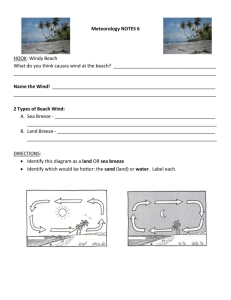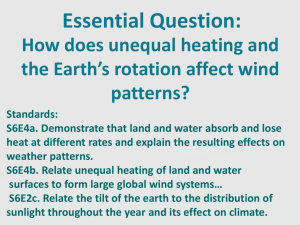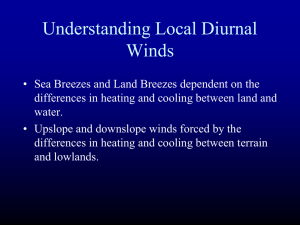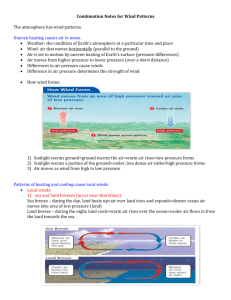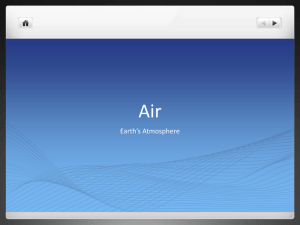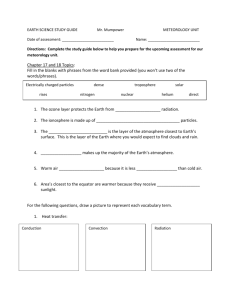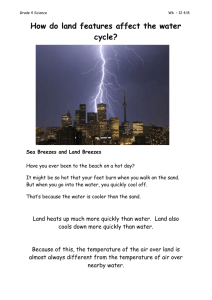Sea Breeze Exploration
advertisement
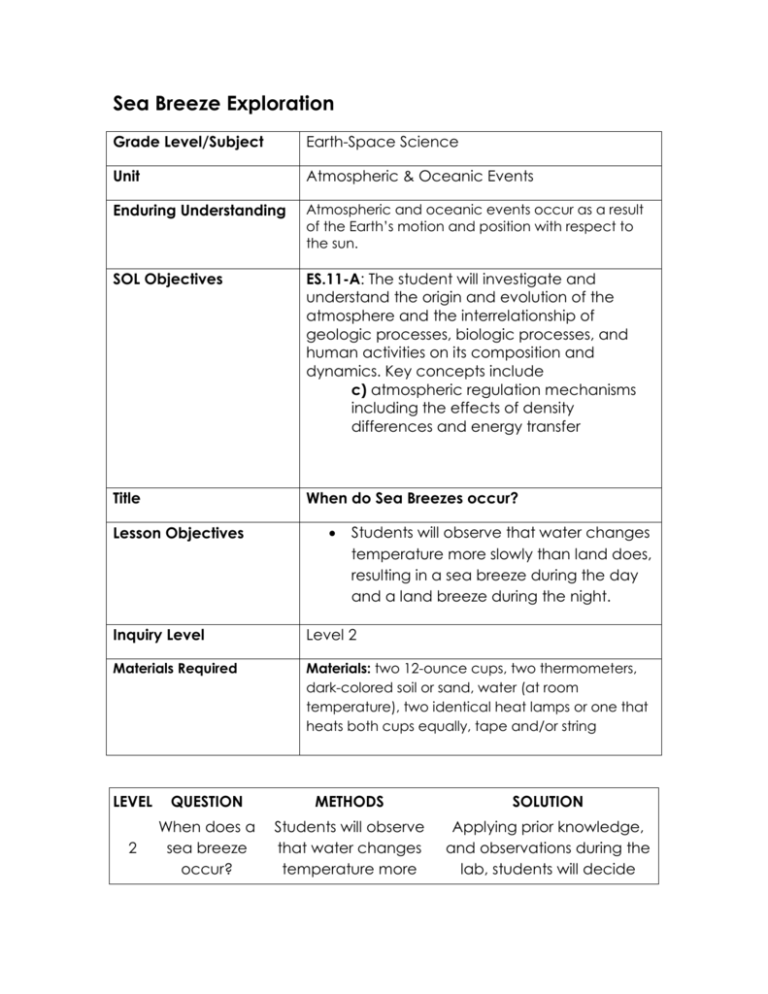
Sea Breeze Exploration Grade Level/Subject Earth-Space Science Unit Atmospheric & Oceanic Events Enduring Understanding Atmospheric and oceanic events occur as a result of the Earth’s motion and position with respect to the sun. SOL Objectives ES.11-A: The student will investigate and understand the origin and evolution of the atmosphere and the interrelationship of geologic processes, biologic processes, and human activities on its composition and dynamics. Key concepts include c) atmospheric regulation mechanisms including the effects of density differences and energy transfer Title When do Sea Breezes occur? Lesson Objectives Students will observe that water changes temperature more slowly than land does, resulting in a sea breeze during the day and a land breeze during the night. Inquiry Level Level 2 Materials Required Materials: two 12-ounce cups, two thermometers, dark-colored soil or sand, water (at room temperature), two identical heat lamps or one that heats both cups equally, tape and/or string LEVEL QUESTION METHODS SOLUTION 2 When does a sea breeze occur? Students will observe that water changes temperature more Applying prior knowledge, and observations during the lab, students will decide slowly than land. when a sea breeze occurs. Upon completion of the lab, students should be able to understand the following: Water changes temperature slower than land does. During the day, land heats up quickly under the Sun, causing air to rise over the land, lowering the temperature over the land, and allowing colder air from the sea to move into its place. This is a sea breeze. A land breeze occurs at night because when the Sun drops below the horizon the air over the land cools faster than the air over the ocean—causing a reverse of the air motion. The amount of background knowledge students should begin with depends on the level of the class. The following is the suggested background knowledge before beginning the lab: Background Knowledge: Hot air rises, lowering the air pressure. Cold air sinks, causing air pressure to rise. Air moves from areas of high pressure to areas of low pressure. Land Breeze: air that moves from the land toward the sea Sea Breeze: air that moves from the sea to the land Time Frame: 2 block periods or 1 block and homework Question: When do sea breezes occur? Procedure: 1. Fill one cup with dark soil or sand and the second cup with water at room temperature 2. Place a thermometer into each cup approximately 2 centimeters from the surface. Tape and/or string may be required to properly secure the thermometer in water 3. Turn on the heat lamp and begin recording the temperature of each substance every 3 minutes for an hour. 4. Graph the data. Report: After gathering data, students should apply the prior knowledge discussed earlier to the data gathered during the experiment and conclude the time of day that sea breezes occur. The written report will include the data they gathered and the graph they chose to visually represent the data. Students will be required to include a sketch to best illustrate the movement of air from sea to land and will be properly labeled and directional arrows. The reasoning that students use to draw their conclusion is also a significant piece of their grade, and must make the connection from “land heating faster than water” to “sea breezes occur during the day.” Rubric is included below. Additional Resources: http://www.classzone.com/books/earth_science/terc/content/visualizatio ns/es1903/es1903page01.cfm http://www.nc-climate.ncsu.edu/edu/k12/.breezes http://www2.vernier.com/sample_labs/ESV-25-COMPland_and_sea_breezes.pdf Sources: Kardos, T. (1997). Easy science demos & labs: Earth science. (2nd ed.). Portland, Main: Walch Publishing. Data (25%) Sketches (25%) Reasoning (25%) Excellent Adequate Present Incomplete Missing Data table is clear and includes all appropriate units. The chosen graph best represents the data collected and is clearly titled and labeled. Data table is clear and includes all appropriate units. The chosen graph best represents the data collected but has a bad title or is unclearly labeled. Either the data table is missing units or the graph is poorly label or the wrong graph for this data. Data Table is present but graph is missing. MISSING Sketch clearly and correctly illustrates the movement of air with directional arrows and labels. Sketch clearly and correctly illustrates the movement of air with directional arrows and labels but is difficult to understand. Sketch clearly but incorrectly illustrates the movement of air with directional arrows and labels. Sketch is incorrect and/or is missing labels and/or directional arrows. MISSING In 3-5 paragraphs, student will clearly explain the reasoning behind their conclusion. Reasoning should connect prior knowledge to conclusion by specifically referencing data collected. In 3-5 paragraphs, student attempted to explain reasoning behind their conclusion but was unclear at times. Reasoning attempted to connect prior knowledge to conclusion by specifically referencing data collected. Student attempted to explain reasoning and connected to prior knowledge and data, but was poorly written and unspecific. Student attempted to explain reasoning and connected to prior knowledge and data, but was less than 3 paragraphs. MISSING Conclusion is correct. Conclusion is correct. Conclusion is clearly defined. Conclusion is given but incorrect and unclear. MISSING Conclusion (25%)
